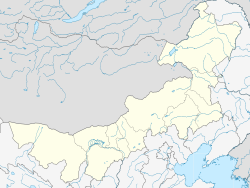Kangbashi District
康巴什区 • ᠬᠢᠶᠠ ᠪᠠᠭᠰᠢ ᠳᠤᠭᠤᠷᠢᠭ | |
|---|---|
 Kangbashi Bridge | |
| Coordinates: 39°35′49″N 109°47′28″E / 39.597°N 109.791°E | |
| Country | China |
| Autonomous region | Inner Mongolia |
| Prefecture-level city | Ordos |
| District seat | Binhe Subdistrict |
| Area | |
| • District | 352 km2 (136 sq mi) |
| • Urban (2018)[1] | 233 km2 (90 sq mi) |
| Population (2020)[2] | |
| • District | 118,796 |
| • Density | 340/km2 (870/sq mi) |
| • Urban | 200,000 |
| • Urban density | 860/km2 (2,200/sq mi) |
| Time zone | UTC+8 (China Standard) |
| Website | www |
| Kangbashi District | |||||||||||||||||
|---|---|---|---|---|---|---|---|---|---|---|---|---|---|---|---|---|---|
| Chinese name | |||||||||||||||||
| Simplified Chinese | 康巴什区 | ||||||||||||||||
| Traditional Chinese | 康巴什區 | ||||||||||||||||
| Hanyu Pinyin | Kāngbāshí Qū | ||||||||||||||||
| |||||||||||||||||
| Mongolian name | |||||||||||||||||
| Mongolian Cyrillic | Хиа багш дугариг | ||||||||||||||||
| Mongolian script | ᠬᠢᠶᠠ ᠪᠠᠭᠰᠢ ᠳᠤᠭᠤᠷᠢᠭ | ||||||||||||||||
| |||||||||||||||||
Kangbashi District (Chinese: 康巴什区; Mongolian: ᠬᠢᠶᠠ ᠪᠠᠭᠰᠢ ᠳᠤᠭᠤᠷᠢᠭ, Hiya Bagsi dûgûrig) is an urban district of the prefecture-level city of Ordos in Inner Mongolia, China.
The district is internationally known for its opulent civic square and monuments and in 2009, made global headlines for having a population of around 30,000 people, which was considered small relative to the grandeur of the built-up space, and was deemed as a "ghost city".[4] However the district's population has grown since in the years afterwards, and had reportedly reached a size of almost 120,000 people in 2021.[5][6]
- ^ Cox, W (2018). Demographia World Urban Areas. 14th Annual Edition (PDF). St. Louis: Demographia. p. 82.
- ^ Inner Mongolia: Prefectures, Cities, Districts and Counties
- ^ Cox, W (2018). Demographia World Urban Areas. 14th Annual Edition (PDF). St. Louis: Demographia. p. 82.
- ^ Jody Rosen (March 6, 2015). "The Colossal Strangeness of China's Most Excellent Tourist City". The New York Times Style Magazine. Retrieved March 9, 2015.
- ^ "China's infamous ghost cities are finally stirring to life". Australian Financial Review. 2021-09-08. Retrieved 2023-09-26.
- ^ Cite error: The named reference
:0was invoked but never defined (see the help page).

